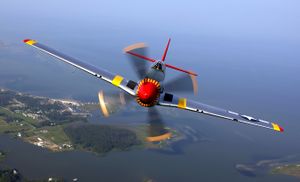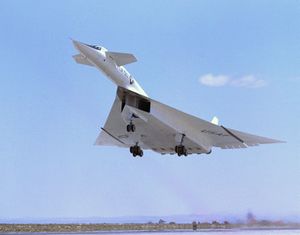PlaneSpottingWorld welcomes all new members! Please gives your ideas at the Terminal.
North American Aviation
Template:Infobox Defunct Company
North American Aviation was a major US aircraft manufacturer. The company was responsible for a number of historic aircraft, including the T-6 Texan trainer, the P-51 Mustang fighter, the B-25 Mitchell bomber, the F-86 Sabre jet fighter, and the X-15 rocket plane, as well as Apollo Command and Service Module, the second stage of the Saturn V rocket, the Space Shuttle orbiter and the B-1 Lancer. Through a series of mergers and sales, North American Aviation is now part of Boeing.
History
Clement Melville Keys founded North American on December 6, 1928, as a holding company that bought and sold interests in various airlines and aviation-relation companies. However, the Air Mail Act of 1934 forced the breakup of such holding companies. The upshot was that North American became a manufacturing company run by James H. "Dutch" Kindelberger (who had been recruited from Douglas Aircraft Company), although it retained Eastern Air Lines until 1938.
General Motors Corporation took a controlling interest in NAA and merged it with its General Aviation division in 1933, but retaining the name North American Aviation.
Kindelberger moved the company's operations to southern California, which allowed flying year-round, and decided to focus on training aircraft, on the theory that it would be easier than trying to compete with established companies. Its first planes were the GA-15 observation plane and the GA-16 trainer, followed by the O-47 and BT-9. The BC-1 of 1937 was North American's first combat aircraft.

Like other manufacturers, North American started gearing up for war in 1940, opening factories in Columbus, Ohio, Dallas, Texas, and Kansas City, Kansas.
North American's follow-on to the BT-9 was the T-6 Texan trainer, of which 17,000 were built, making it the most widely used trainer ever. The twin-engine B-25 Mitchell bomber achieved fame in the Doolittle Raid and was used in all theaters. The A-36 Apache was developed as a ground attack aircraft and dive bomber. Originally powered by an Allison engine, a suggestion by the RAF that North American switch to the Rolls-Royce Merlin engine may have been one of the most significant events in WWII aviation, as it produced the P-51 Mustang, considered by many to be the best American fighter of the war.
Post-war, North American's employment dropped from a high of 91,000 to 5,000 in 1946. Two years later in 1948, General Motors divested NAA as a public company. Nevertheless, it continued with new designs, including the T-28 Trojan trainer and attack aircraft, the odd-looking P-82 Twin Mustang, B-45 Tornado jet bomber, the FJ Fury fighter, AJ Savage, the revolutionairy XB-70 Valkyrie Mach-3 strategic bomber, Shrike Commander, and T-39 Sabreliner business jet.
The Columbus, Ohio division of North American Aviation was instrumental in the exclusive development and production of North American's A-5 Vigilante, an advanced high speed bomber that would see significant use as a Naval reconnaissance aircraft during the Vietnam War, the OV-10 Bronco, the first aircraft specifically designed for forward air control (FAC), and counter-insurgency (COIN) duties, and the T-2 Buckeye Naval trainer, which would serve from the late 1950s until 2005 and be flown in training by virtually every Naval pilot for four decades. The Buckeye's name would be an acknowledgement to the state tree of Ohio, as well as the mascot of Ohio State University.

The F-86 Sabre started out as a redesigned Fury and achieved fame shooting down MiGs in the Korean War. Over 9,000 F-86s were produced. Its successor, the F-100 Super Sabre, was also popular.
The rocket engine division spun off into a separate company, Rocketdyne, in 1955, but North American designed and built the X-15.
The cancellation of the F-107 and F-108 programs in the late 1950s, as well as the cancellation of the Navaho intercontinental cruise missile program, was a blow to North American from which it never fully recovered. In 1960, the new CEO Lee Atwood decided to focus on the space program, and the company was the chief contractor for the Apollo Command/Service Module and the second stage of the Saturn V. However, the Apollo 1 fire in January 1967 was partly blamed on the company, and in March they merged with Rockwell-Standard, then known as North American Rockwell. The company changed its name to Rockwell International and named its aircraft division North American Aircraft Operations in 1973.[1]
Boeing merger
In December 1996, the defense and space divisions of Rockwell International (including the North American Aviation and Rocketdyne divisions) were sold to Boeing, which integrated the product lines into their Integrated Defense Systems division. Rocketdyne was eventually sold by Boeing to UTC Pratt & Whitney, in 2005.
List of aircraft manufactured
- P-51 Mustang
- P-82 Twin Mustang
- B-25 Mitchell
- F-86 Sabre
- F-100 Super Sabre
- YF-107
- T-6 Texan
- L-17 Navion
- T-28 Trojan
- T-2 Buckeye
- XB-21
- O-47
- BT-9
- A-36 Apache
- XB-28 Dragon
- AJ Savage
- P-64
- T-39 Sabreliner
- B-45 Tornado
- FJ Fury
- YF-93
- X-10
- A-5 Vigilante
- XF-108 Rapier
- OV-10 Bronco
- X-15
- XB-70 Valkyrie
References
- Hagedorn, Dan. North American NA-16/AT-6/SNJ. North Branch, MN: Specialty Press, 1997. ISBN 0-933424-84-1.
- Fletcher, David & Macphail, Doug. Harvard - The North American Trainers in Canada. Dundas, ON:DCF Flying Books, ISBN 0-9693825-0-2
External links
- North American Aviation history
- Centennial of Flight page on North American
- Aerospace Legacy Foundation
- AeroWeb: List of NAA aircraft
Lists relating to aviation | |
|---|---|
| General | Timeline of aviation · Aircraft · Aircraft manufacturers · Aircraft engines · Aircraft engine manufacturers · Airports · Airlines |
| Military | Air forces · Aircraft weapons · Missiles · Unmanned aerial vehicles (UAVs) · Experimental aircraft |
| Notable incidents and accidents | Military aviation · Airliners · General aviation · Famous aviation-related deaths |
| Records | Flight airspeed record · Flight distance record · Flight altitude record · Flight endurance record · Most produced aircraft |
Template:North American Aviation aircraft
cs:North American Aviation da:North American Aviation de:North American Aviation es:North American Aviation fr:North American he:נורת' אמריקן אוויאיישן ja:ノースアメリカン no:North American Aviation Inc. pl:North American Aviation pt:North American Aviation zh:北美人航空 sv:North American Aviation
| This article is licensed under the GNU Free Documentation License. It uses material from the Wikipedia article "North American Aviation". |

